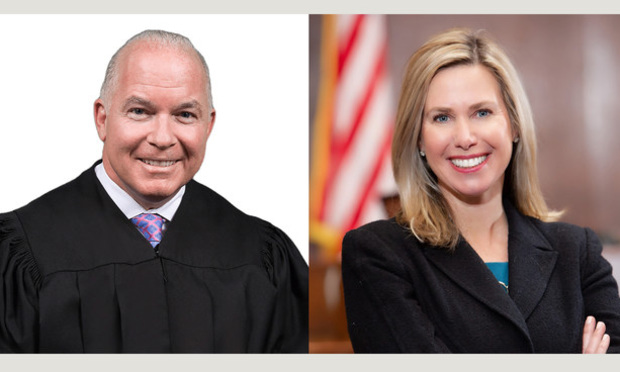With Split Decision in Pa. Superior Court, Republicans Pull Off a Statewide Surprise
"When you're looking at a subtle difference in the number of votes, I think the bar recommendation does matter," political consultant Larry Ceisler said. "When you can do negative ads and negative digital saying you're 'not recommended' by the bar, to a certain voter that makes a difference."
November 06, 2019 at 05:09 PM
6 minute read
 Judge Daniel McCaffery (left) and Megan McCarthy King (right).
Judge Daniel McCaffery (left) and Megan McCarthy King (right).
Court watchers and politicos said Pennsylvania Republicans had reason to celebrate the result of the single partisan statewide race on the ballot, for two seats on the Superior Court, with each major party electing one new judge.
The result, observers said, bucked a trend toward election of Democrats to statewide offices in the past decade, a trend that continued to accelerate in local races in the Philadelphia suburbs.
On Tuesday, four candidates for the state Superior Court faced off for two open seats on the intermediate appellate court bench. By Wednesday afternoon, with 99% of the votes counted, Philadelphia Court of Common Pleas Judge Daniel McCaffery, a Democrat, and Chester County prosecutor Megan McCarthy King, a Republican, appeared to be the winners, taking the top spots in the race. The pair were poised to edge out the two other candidates, Democrat Amanda Green-Hawkins and Cumberland County Judge Christylee Peck, by a thin margin— slightly more than two percentage points from the highest to the lowest vote-getter.
McCaffery, according to the Pennsylvania Department of State, earned 1,242,716 votes, barely edging out the 1,236,786 cast for King. Green-Hawkins trailed King by less than 32,000 votes, earning 1,204,875. Peck was the lowest vote-getter, according to the numbers, having 1,148,106 ballots cast for her.
"That's fairly rare to see where it gets split like that, and so close. That's a big surprise," G. Terry Madonna, a political analyst and director of the Center for Politics and Public Affairs at Franklin & Marshall College, said. "I thought that Dems would win the statewide Superior Court election likely because of what we knew was going to happen in the Philadelphia suburbs, where the Democrats, for more than a decade, have been making inroads."
Several other political observers also said the results were unexpected.
"In this political environment, when you see how much money was spent, I think it's very surprising the Democrats did not win both," Larry Ceisler of Ceisler Media said.
Christopher Borick, political science professor at Muhlenberg College, offered similar sentiments, saying that, given how the political headwinds appeared to favor the Democrats nationally, the expectation was for a strong Democratic showing.
"As the results show, that wasn't the case with a split ticket," Borick said. "That to me is a little surprising."
Veteran Republican consultant Christopher Nicholas, however, said there was a lot of enthusiasm surrounding the two GOP candidates, who, he said, had great credentials and campaigned well.
"Megan King's victory is clearly a nice shot in the arm for the state GOP," Nicholas said. "I'm sorry Judge Peck didn't pick up the other slot."
Bar Rating's Impact
Judicial races are typically low-information contests, where candidates are restricted from soliciting for donations or discussing topics as openly as nonjudicial candidates. To help bridge this gap, bar associations will evaluate the candidates and publish ratings for the public.
In the spring, the Pennsylvania Bar Association rated McCaffery as "highly recommended," and rated both King and Peck as "recommended." Green-Hawkins received a "not recommended" rating.
However, the perennial question is, how effective are those ratings on the choice in the ballot box?
According to some, a positive rating from the bar-aligned judicial rating group could have provided a boost.
The "not recommended" rating, judicial selection watchers said, could have been a deciding factor in such a close race.
"When you're looking at a subtle difference in the number of votes, I think the bar recommendation does matter," Ceisler said. "When you can do negative ads and negative digital saying you're 'not recommended' by the bar, to a certain voter that makes a difference."
Nicholas said the bar rating was something he used to help develop a campaign theme for the GOP candidates.
"I pounded on the theme that [the Republic ticket] was the only endorsed team. Because Amanda Green-Hawkins was 'not recommended' by the bar, they couldn't say that," he said. "I think that may have had a helping hand somewhat too."
Mark Harris, a partner at the media agency Cold Spark, which made some of the TV ads for King, agreed that Green-Hawkins' "not recommended" rating was likely a challenge for her campaign, and being able to run as a "recommended team" was helpful. However, he said, it's also likely not many voters were aware of the ratings.
Harris credited the Republicans' success with picking candidates who campaigned hard.
"Due to the Democratic spending advantage and just McCaffery being a big name, a lot of people expected he was going to run away with this thing, and that's not what happened and I think that's a credit to the campaign that Megan McCarthy King and Christylee Peck ran," Harris said. "They worked hard."
King, he noted, also faced negative ads tying her to national politics, but to overcome that message, he said they focused their TV ads on telling her story as a prosecutor and mother.
In a statement issued late Wednesday, McCaffery credited the hard work of his team getting out his campaign's message to "every corner of Pennsylvania."
"I will take the stories and the concerns of each and every person that I met with me to the Superior Court," he said, thanking his supporters and saying he was both "thrilled" and "humbled" by the win.
When it comes to using the 2019 results as an indicator of how 2020 might shake out, political observers said judicial races—especially those taking place in an off-year—are unique, but noted that long-standing trends of the southwest turning red and the southeast turning blue seem to have solidified in 2019.
And, according to Nicholas, that may be something the GOP might want to watch out for.
"It's great that you took over Greene and Fayette county, but it takes a lot of Greene and Fayette counties to make up for Chester County," he said.
This content has been archived. It is available through our partners, LexisNexis® and Bloomberg Law.
To view this content, please continue to their sites.
Not a Lexis Subscriber?
Subscribe Now
Not a Bloomberg Law Subscriber?
Subscribe Now
NOT FOR REPRINT
© 2025 ALM Global, LLC, All Rights Reserved. Request academic re-use from www.copyright.com. All other uses, submit a request to [email protected]. For more information visit Asset & Logo Licensing.
You Might Like
View All
Lawsuit Against Major Food Brands Could Be Sign of Emerging Litigation Over Processed Foods
3 minute read

People in the News—Jan. 23, 2025—Marshall Dennehey, Duane Morris, Hangley Aronchick
3 minute read
Plaintiff Argues Jury's $22M Punitive Damages Finding Undermines J&J's Talc Trial Win
4 minute readTrending Stories
- 1No Two Wildfires Alike: Lawyers Take Different Legal Strategies in California
- 2Poop-Themed Dog Toy OK as Parody, but Still Tarnished Jack Daniel’s Brand, Court Says
- 3Meet the New President of NY's Association of Trial Court Jurists
- 4Lawyers' Phones Are Ringing: What Should Employers Do If ICE Raids Their Business?
- 5Freshfields Hires Ex-SEC Corporate Finance Director in Silicon Valley
Who Got The Work
J. Brugh Lower of Gibbons has entered an appearance for industrial equipment supplier Devco Corporation in a pending trademark infringement lawsuit. The suit, accusing the defendant of selling knock-off Graco products, was filed Dec. 18 in New Jersey District Court by Rivkin Radler on behalf of Graco Inc. and Graco Minnesota. The case, assigned to U.S. District Judge Zahid N. Quraishi, is 3:24-cv-11294, Graco Inc. et al v. Devco Corporation.
Who Got The Work
Rebecca Maller-Stein and Kent A. Yalowitz of Arnold & Porter Kaye Scholer have entered their appearances for Hanaco Venture Capital and its executives, Lior Prosor and David Frankel, in a pending securities lawsuit. The action, filed on Dec. 24 in New York Southern District Court by Zell, Aron & Co. on behalf of Goldeneye Advisors, accuses the defendants of negligently and fraudulently managing the plaintiff's $1 million investment. The case, assigned to U.S. District Judge Vernon S. Broderick, is 1:24-cv-09918, Goldeneye Advisors, LLC v. Hanaco Venture Capital, Ltd. et al.
Who Got The Work
Attorneys from A&O Shearman has stepped in as defense counsel for Toronto-Dominion Bank and other defendants in a pending securities class action. The suit, filed Dec. 11 in New York Southern District Court by Bleichmar Fonti & Auld, accuses the defendants of concealing the bank's 'pervasive' deficiencies in regards to its compliance with the Bank Secrecy Act and the quality of its anti-money laundering controls. The case, assigned to U.S. District Judge Arun Subramanian, is 1:24-cv-09445, Gonzalez v. The Toronto-Dominion Bank et al.
Who Got The Work
Crown Castle International, a Pennsylvania company providing shared communications infrastructure, has turned to Luke D. Wolf of Gordon Rees Scully Mansukhani to fend off a pending breach-of-contract lawsuit. The court action, filed Nov. 25 in Michigan Eastern District Court by Hooper Hathaway PC on behalf of The Town Residences LLC, accuses Crown Castle of failing to transfer approximately $30,000 in utility payments from T-Mobile in breach of a roof-top lease and assignment agreement. The case, assigned to U.S. District Judge Susan K. Declercq, is 2:24-cv-13131, The Town Residences LLC v. T-Mobile US, Inc. et al.
Who Got The Work
Wilfred P. Coronato and Daniel M. Schwartz of McCarter & English have stepped in as defense counsel to Electrolux Home Products Inc. in a pending product liability lawsuit. The court action, filed Nov. 26 in New York Eastern District Court by Poulos Lopiccolo PC and Nagel Rice LLP on behalf of David Stern, alleges that the defendant's refrigerators’ drawers and shelving repeatedly break and fall apart within months after purchase. The case, assigned to U.S. District Judge Joan M. Azrack, is 2:24-cv-08204, Stern v. Electrolux Home Products, Inc.
Featured Firms
Law Offices of Gary Martin Hays & Associates, P.C.
(470) 294-1674
Law Offices of Mark E. Salomone
(857) 444-6468
Smith & Hassler
(713) 739-1250





